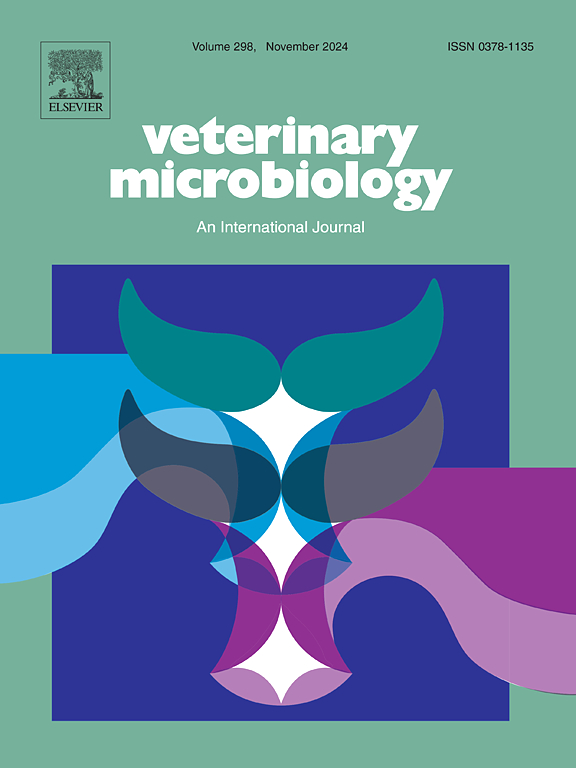FAdV-4 infection induces selective mitochondrial autophagy
IF 2.4
2区 农林科学
Q3 MICROBIOLOGY
引用次数: 0
Abstract
Fowl adenovirus serotype 4 (FAdV-4) is an infectious pathogen that poses a significant threat to the poultry industry. It is widely disseminated globally and is characterized by high infection and mortality rates. Mitochondria, as multifunctional dual membrane-enclosed eukaryotic organelles, maintain cellular homeostasis through various mechanisms. However, how FAdV-4 infection alters mitochondrial dynamics has not been previously established. In this study, transmission electron microscopy and immunofluorescence techniques were used to confirm that FAdV-4 infection can significantly alter mitochondrial morphology, disrupt mitochondrial fusion-fission homeostasis, and promote changes in the spatial distribution of mitochondria, causing them to gather around the nucleus. This leads to increased contact and interaction with other organelles. Preliminary analyses of the mechanistic basis for FAdV-4-mediated disruption of mitochondrial homeostasis revealed that the virus can induce selective mitophagy via the classical PINK1/Parkin signaling pathway and promote its own replication, which was confirmed by Western blotting. The novel findings regarding the ability of FAdV-4 to regulate mitochondrial morphology and function discussed in this study represent an important step forward, providing a foundation for further efforts to explore the underlying pathogenic mechanisms and to develop adjuvant approaches to preventing or managing FAdV-4 infection.
FAdV-4感染诱导选择性线粒体自噬
禽腺病毒血清型4 (FAdV-4)是一种传染性病原体,对家禽业构成重大威胁。它在全球广泛传播,其特点是高感染率和高死亡率。线粒体作为一种多功能双膜封闭的真核生物细胞器,通过多种机制维持细胞内稳态。然而,FAdV-4感染如何改变线粒体动力学先前尚未确定。本研究通过透射电镜和免疫荧光技术证实,FAdV-4感染可显著改变线粒体形态,破坏线粒体融合-裂变稳态,促进线粒体空间分布的变化,使其聚集在细胞核周围。这导致与其他细胞器的接触和相互作用增加。对fadv -4介导的线粒体稳态破坏机制基础的初步分析表明,该病毒可通过经典的PINK1/Parkin信号通路诱导选择性线粒体自噬,并促进自身复制,Western blotting证实了这一点。本研究中关于FAdV-4调节线粒体形态和功能的能力的新发现是向前迈出的重要一步,为进一步探索潜在的致病机制和开发预防或控制FAdV-4感染的辅助方法提供了基础。
本文章由计算机程序翻译,如有差异,请以英文原文为准。
求助全文
约1分钟内获得全文
求助全文
来源期刊

Veterinary microbiology
农林科学-兽医学
CiteScore
5.90
自引率
6.10%
发文量
221
审稿时长
52 days
期刊介绍:
Veterinary Microbiology is concerned with microbial (bacterial, fungal, viral) diseases of domesticated vertebrate animals (livestock, companion animals, fur-bearing animals, game, poultry, fish) that supply food, other useful products or companionship. In addition, Microbial diseases of wild animals living in captivity, or as members of the feral fauna will also be considered if the infections are of interest because of their interrelation with humans (zoonoses) and/or domestic animals. Studies of antimicrobial resistance are also included, provided that the results represent a substantial advance in knowledge. Authors are strongly encouraged to read - prior to submission - the Editorials (''Scope or cope'' and ''Scope or cope II'') published previously in the journal. The Editors reserve the right to suggest submission to another journal for those papers which they feel would be more appropriate for consideration by that journal.
Original research papers of high quality and novelty on aspects of control, host response, molecular biology, pathogenesis, prevention, and treatment of microbial diseases of animals are published. Papers dealing primarily with immunology, epidemiology, molecular biology and antiviral or microbial agents will only be considered if they demonstrate a clear impact on a disease. Papers focusing solely on diagnostic techniques (such as another PCR protocol or ELISA) will not be published - focus should be on a microorganism and not on a particular technique. Papers only reporting microbial sequences, transcriptomics data, or proteomics data will not be considered unless the results represent a substantial advance in knowledge.
Drug trial papers will be considered if they have general application or significance. Papers on the identification of microorganisms will also be considered, but detailed taxonomic studies do not fall within the scope of the journal. Case reports will not be published, unless they have general application or contain novel aspects. Papers of geographically limited interest, which repeat what had been established elsewhere will not be considered. The readership of the journal is global.
 求助内容:
求助内容: 应助结果提醒方式:
应助结果提醒方式:


